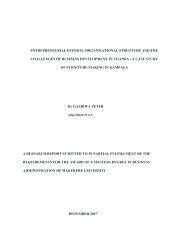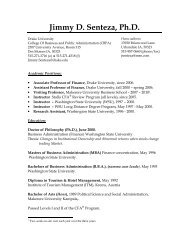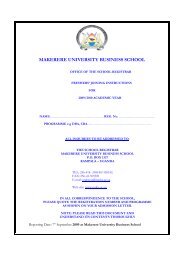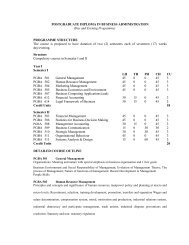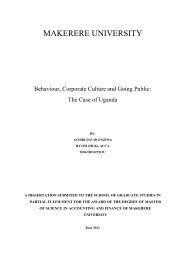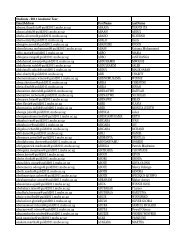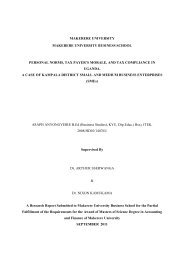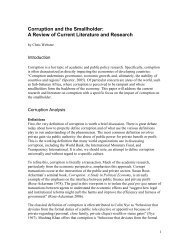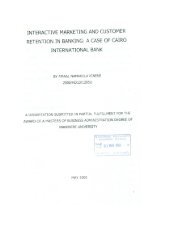13th Annual International Management Conference Proceeding
13th Annual International Management Conference Proceeding
13th Annual International Management Conference Proceeding
Create successful ePaper yourself
Turn your PDF publications into a flip-book with our unique Google optimized e-Paper software.
who are socially disadvantaged. Deeply committed to generating social value, these entrepreneurs identify<br />
new processes, services, products or unique ways of combining proven practice with innovation, driving<br />
through pattern-breaking approaches to resolve seemingly intractable problems. These are men and women<br />
who seize the problems created by change as opportunities to transform societies” (Fiet, 2000).<br />
2.1 Relationship between perceived desirability, Perceived feasibility and cognitive and emotional characteristics.<br />
Perceived desirability refers to the attractiveness of generating the entrepreneurial event; while perceived<br />
feasibility refers to the degree to which one believes that he or she is personally capable of forming a<br />
company (Shapero & Sokol, 1982). This suggests that individuals vary in their perceptions of what they find<br />
feasible and what is desirable. These perceptions, which are shaped by the individuals’ cultural and social<br />
environment, largely determine which actions are taken in order to set up a company (Shapero & Sokol,<br />
1982). While not explicitly referring to intentions, intentions are embedded in the behavior that produces<br />
the entrepreneurial event.<br />
The theory of planned behaviour (TPB) suggests that behavioral intentions are affected by attitude towards<br />
the behaviour, subjective (social) norms and perceived behavioral control (Ajzen, 1991). It ca be implied<br />
from this that perceived desirability corresponds to social norms and attitudes, while perceived feasibility<br />
relates to self efficacy beliefs, a concept associated with behavioral control (Krueger Jr. & Brazeal, 1994).<br />
Literature also shows that stable individual traits and situational factors do not exert a direct effect on<br />
intentions and behaviour but indirectly through perceptions of desirability and feasibility (Krueger Jr. &<br />
Reilly, 2000).<br />
Kim and Hunter,(1993) empirically show that intentions predict behavior but also that attitudes predict<br />
intentions. TPB emphasizes attitudes towards behavior as powerful antecedents of intentions. In the context<br />
of entrepreneurship, Kruger related these attitudes directly with perceived desirability (Kruger Jr & Brazeal,<br />
1994). Mair and Naboa, (2003) suggest that attitudes involving cognitive and emotional dimensions are<br />
helpful in understanding the social entrepreneurial process. These include empathy and moral judgment.<br />
Traditionally the literature has distinguished between affective (emotional) and cognitive empathy<br />
(Lopez,Apodaka et al.,1994;Mehrbian &Epstein,1972). Authors following the former approach refer to<br />
empathy as an affective response, as something to be aroused. Oswald provides a very straightforward<br />
definition and refers to empathy as a feeling, a “vicarious affective arousal” (Oswald, 1996:614). For the<br />
purpose of this paper empathy is defined as the ability to intellectually recognize and emotionally share the<br />
emotions or feeling of others.<br />
Empathy has been studied extensively in the context of helping behavior, a concept that is related to the<br />
spirit of social entrepreneurship Bannet et.al found that perceived helping skills increased the likelihood that<br />
empathy triggers a helping response (Barnet, Thomson &Pfeifer, 1984). Goldman et al also proposed that<br />
direct requests for help also positively affect the empathy-helping response link (Goldman, Broll, & Carril,<br />
1983). Building on this evidence that empathy is positively associated with helping responses, it is implied<br />
that a person who is capable of intellectually recognizing and emotionally sharing another person’s emotions<br />
and feeling will develop a desire to help and do whatever is necessary to avoid another’s suffering. In this<br />
paper, a suggestion is made to add a set of moderating variable of social capital to further explain its<br />
influence on social entrepreneurial behavior.<br />
Lopez,Apodaka et al (1994) in support of social entrepreneurship identified certain conditions regarding the<br />
beneficiary(who receives help) and the provider (who offers help) that facilitate empathy. The greater the<br />
amount of help needed, and the closer the ties between the beneficiary and the provider, the greater the<br />
likelihood the beneficiary will receive help. The more positive the provider’s psychological state, the more<br />
familiar the beneficiary’s problems, and the lower the cost of helping, the greater the likelihood the provider<br />
will offer help. Goldman, Broll et al. (1983) also found that a direct request for help, i.e. explicitly asking<br />
someone to help, is more likely to obtain an empathic response than an empathic response than an indirect<br />
one.<br />
Specific research in social entrepreneurship indicates that sensitivity to other’s feelings motivates social<br />
entrepreneurs to create social enterprise (Prabhu, 1999). However, not everybody with the ability to<br />
61



